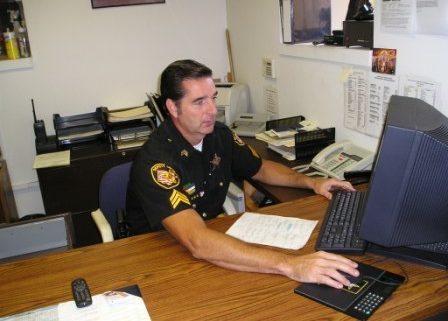Court Security Officers
The responsibility of protecting county courtrooms, judges, jury members, court employees, witnesses, and all citizens who attend court hearings and trials, falls on the shoulders of the county sheriff. The sheriff is also responsible for transporting jail inmates to and from their court appearances, and for guarding the prisoners while they’re inside the courthouse.
US Marshals have the responsibility of providing security and prisoner transport for federal courts.
Sheriffs deputies employed as court security officers undergo special training related to working in a court environment. Depending on an individual sheriff’s policy, court security officers may, or may not, be certified police officers.
The sergeant (you can tell he’s a sergeant by the three stripes on his sleeve and collar pin) in the above photograph is in charge of all courtroom security operations. In addition to supervising the deputies working in the various courtrooms, he’s responsible for delivering each prisoner to the correct courtroom on time.
Closed circuit cameras in each courtroom and other strategic locations, project real-time images to the security office. Judges also have panic buttons beneath their benches. A press of the button sends an emergency signal to the security office, and to police dispatchers and the nearby sheriffs office.
Deputies gather chains in preparation of transporting prisoners back to jail.

Court security officers must learn to use various screening devices, such as hand-held metal detecting wands and x-ray equipment.
Monitors for x-ray equipment.

Officer stationed at x-ray machine and walk-through metal detector.

Typical courtroom

Jury box

Prisoner holding cell in court basement near the security office.








Lee,I apologize. I did get your e-mail, but I’m damned if I can find it now. I know the answer was ‘yes.” but please send your address again so we can nail down the details.
I am very tickled by the changes in both technology and procedure since I was first called for jury duty in Chicago in 1965. At that time they had men and women in separated rooms ruled over by a joint “sargents desk”.
Because the prisoners got away so regularly they had a system set up if a woman need the restroom. She was required to stand next to her chair while the gal at the desk would yell “Got another leaker”, and call on the next nine women who raised their hands.
We weren’t allowed to go unless there were ten of us. We were lined up by height, moved into twos, told to shuffle-walk, and were preceded and followed by armed guards.
At the rest room door we stood – not talking – while the gal in front went in to check the stalls for hiders. If all was well we were allowed in.
Guess it was easier to keep us under control than the prisoners 🙂
JD – That one had me laughing out loud. It also reminded my of the time back in the 70s when the powers to be decided to install a bullet-proof glass shield on the circuit court judge’s bench.
They brought us all in to see the newfangled, life-saving, indestructible barrier that would separate the judge from those who could do him harm. It was cool, and very, very expensive. Thirty minutes later a janitor bumped it with a mop handle while he was tidying up. The glass shattered in a zillion pieces. I suppose the judge would have been safe as long as his attacker didn’t charge him with a mop.
By the way, did you get my email?
On the subject of “the panic button”: for a while, our civil District Court was part of a mandatory non-binding arbitration program. Disputes under 15,000 dollars would be sent to a pre-trial arbitration, in which an arbitrator would hear an informal presentation of the evidence, usually in the form of affidavits and documents, and make a ruling as to liability and/or damages. If either party didn’t like the ruling, they were free to file an objection and go on to trial. The arbitrators were lawyers who agreed to participate in the program, and I was one of them.
My first arbitration hearing was held in a small magistrate’s courtroom. I got to sit up on the bench, even though I didn’t get to wear the robe. Still, I was thinking, “This is pretty neat. Hey, I wonder what this little thing that looks like a TV remote is for…”
No one had told me about the panic button.
Boy, was I surprised when three deputies came piling in! Fortunately, they were pretty good humored about it and they only ribbed me about it for, oh, five years or so.
That’s when the last of them retired.
Our courhouse uses deputies, although recently I believe they’ve started using volunteers to take juries from the jury pool room to the courtrooms which frees up officers for more significant duty.
I also noticed that the metal detectors at the courhouse seem to be the most sensitive I’ve ever encountered. Stuff I wear to the airport that doesn’t bother the detectors sets off the ones at the courthouse — even a tiny watch with a leather strap.